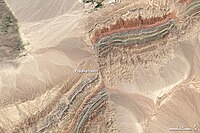
Photo from wikipedia
Xi’an ground fractures are the most typical ground fractures in China. Fourteen fractures have nearly divided the historical city into several distinct sections. These fractures are parallel and distributed in… Click to show full abstract
Xi’an ground fractures are the most typical ground fractures in China. Fourteen fractures have nearly divided the historical city into several distinct sections. These fractures are parallel and distributed in NEE direction at the same interval, with all features exhibiting a down dropping southerly block which extends to connect with the underlying fault. The activities of fractures are primarily expressed as normal faults. The faulted strata are well defined and dislocation displacement increases with depth. Thus, fractures have the characteristics of syn-sedimentary faults, which constitute the hanging wall of the Lintong-Chang’an fault branch system. Crustal thinning caused by the uplifting of upper mantle provides a power source for extension and stretching along the fracture surface of the upper crust, which results in a series of extensional faults and the suitable conditions for forming massive ground fractures. The movement of tectonic blocks influences the normal dip-slipping tension of Lintong-Chang’an fault branches, and produces a series of secondary tectonic fractures adjacent to surface, which constitute the prototype of ground fractures. The recent regional tensile stress produced by modern mainland deformation, also profoundly influences the current activity of Xi’an ground fractures.
Journal Title: Journal of Earth Science
Year Published: 2018
Link to full text (if available)
Share on Social Media: Sign Up to like & get
recommendations!